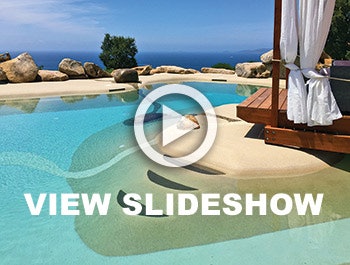All photos courtesy of Biodesign, USA
"Why isn't this available in the United States?"
That was Francis Leogrande’s first reaction upon seeing a completely new kind of pool at the Piscine Global Swimming Pool show in Lyon, France. Robert Drucker, president of All Island Group and his wife Carol Drucker had come across the pools at the show and along with Leogrande, they knew immediately that they had found something entirely new.
The Druckers and Leogrande, national sales manager at All Island Group, a builder/supplier based in Farmingdale, N.Y., were fascinated by the pool’s unique structure: It had a beach entry on all sides, lending a natural, organic look to the pool.
RELATED: The Pool as Mirror
His company is now building and marketing the pools in the U.S. and Canada under the name Biodesign USA. The vessels first appeared in Italy 14 years ago and now include more than 6,000 installations throughout Europe, sold by more than 400 dealers.
The idea behind this type of pool, he explains, originally grew out of a desire to build pools without having to design, engineer and install reinforced concrete structures, which have long dominated the industry. "This was a way to build a pool without having to use structural concrete or having to have vertical walls. You can dig these pools without disturbing the area around the pool. You can put them right next trees without damaging them. That's how unobtrusive they are."
In a sense, he explains, it's like a pond in the fact that the contours of the excavation function as the structural base, as opposed to a reinforced concrete structure. "What that means," he says, "is that if you want a beach entry, sun shelf, steps or a bench, you're actually creating that design in the dirt."
ON THE BEACH
By far the most distinctive aspect of Biodesign projects are, as mentioned above, the edges of the pool, which mostly look and function like beach entries that can surround the water on all sides. "In effect, the beach replaces the hard edges that we associate with pools," Leogrande explains.
The distinctive edge treatment harmonizes well, he says, with the rising popularity of bench entries, tanning shelves and overall shallower pools. By extending the sculpted beaches around most or all of the pool's border, entry and egress, lounging and areas for small children encompass the entire vessel, making the pools more inviting and more visually diffused into the landscape than a typical swimming pool.
RELATED: Swim Ponds vs Natural Swimming Pools — Two Sides of the Same Coin
"The first people who contacted us were from pool companies doing natural looking swimming pools but couldn't come up with a way to remove the coping through regular gunite construction," he explains. "We heard that constantly: How do we make a beach entry look like a real beach? With these pools you bypass that whole issue of how you orchestrate that outside of the pool with the inside of the pool. It's a much more gentle and natural-looking transition."
Although the construction method (described below) does allow for vertical walls and even traditional coping and decking, the signature beach look is truly the Biodesign calling card. By softly interfacing with the landscape, the pools, or ponds, are conducive to both small spaces as well as sprawling bodies of water across a range of styles. "You're not overwhelming a small yard with a box and its harsh lines," he says. "Or you can create large inviting shallow areas in bigger projects. It works with any design style or setting."
All of that, he explains, gives both the designer and homeowner tremendous freedom and flexibility in personalizing the space, often in very subtle ways. "It's unusual compared to the standard pool," he says, "and certainly, it's not for everybody. But we find that many people appreciate the unobtrusive way it fuses into the landscape."
SEVEN LAYERS
The construction process calls for a seven-step, layered process that appropriates techniques from both the pool and pond industries.
Step 1:
Unlike typical pool installations, the excavation process involves detailed contouring to create the pool's shape and internal features. In addition, the sides of the pool are gently sloped at 10- to 50-degree angles.
Step 2:
An initial layer of geo-textile material is placed over the excavation to protect the EDPM liner from potential damage caused by sharp objects.
Step 3:
An EPDM (ethylene propylene diene monomer) waterproof liner is placed over the geo-textile sheet. Highly elastic, the EPDM liner conforms to any change in ground movement without damage. The liners are made by Firestone using a heavy-duty material typically used in retention ponds. The material can be stretched up to 300 percent.
Step 4:
Structural netting material is placed over the EPDM liner.
Step 5:
A rough structural paving layer is spread over the entire area by hand using a mixture of natural granulated quartz and non-toxic resin.
Step 6:
A second structural net is placed over the structural paving rough layer.
Step 7:
Granulated stone and non-toxic resins are blended and spread over the surface by hand. A final layer of resin is applied after a light sanding.
FLEXIBLE AND PERVIOUS
Similar to ponds that use combinations of geotextiles, liners and concrete, all the materials except the liner are pervious. Leogrande explains that because water moves through the material, the only weight on the surface comes from bathers, not the water itself. The pervious materials also offer the advantage of not counting as impermeable structures in areas where regulations limit how much of a property can be covered in hardscape.
(Currently, multiple municipalities have approved its use for patios where conventional patio is not allowed.)
RELATED: The Art of Natural-Looking Swimming Ponds
Biodesign offers 10 different surface materials, from relatively smooth quartzite aggregate surfaces to larger pebble aggregates, all of which are similar to exposed aggregate surfaces used in pools. Because the Biodesign structure is somewhat flexible, surface expansion joints are installed at roughly 20-foot intervals to control shifting due to ground movement or freeze/thaw cycles. These pools have been installed in northern Europe's extreme climates for 14 years with no issues from freeze and thaw, Leogrande says.
"We typically recommend using the pebble surfaces in the expansion joints to control any shifting that might occur," he adds. "Because the liner itself is so flexible, ground movement has no effect on the pool's ability to hold water and because the liner is so well protected, it's never going to puncture.
"Circulation is handled via stainless steel box skimmers that contain manifolds for both return and air lines. Flex PVC plumbing lines for both air and returns are attached to ports in the manifolds and are glued across the top of the liner to the desired locations and then subsequently concealed and protected on two sides by the layers that are installed on top of the liner.
"Unless you cut a main drain in the liner, there's no need for any liner penetrations," Leogrande explains.
CATCHING ON
Leogrande is understandably excited how the Biodesign concept is performing in the U.S. and Canada. If the success in Europe is any indication, more and more American companies and consumers will find the concept appealing enough as an alternative to gunite, fiberglass, package pools and stainless steel.
"The real reason they've caught on is that there's nothing else like these pools with the same look and feel. Also, it's not really restricted to the pool world with so many different types of applications in and out of the water. I'm passionate about these pools for several reasons, but mainly because they have a widespread appeal that's very different than what we typically think of as a swimming pool or a pond."
RELATED: And Now For Something Completely Different
For further information, contact Francis Leogrande at [email protected].













































